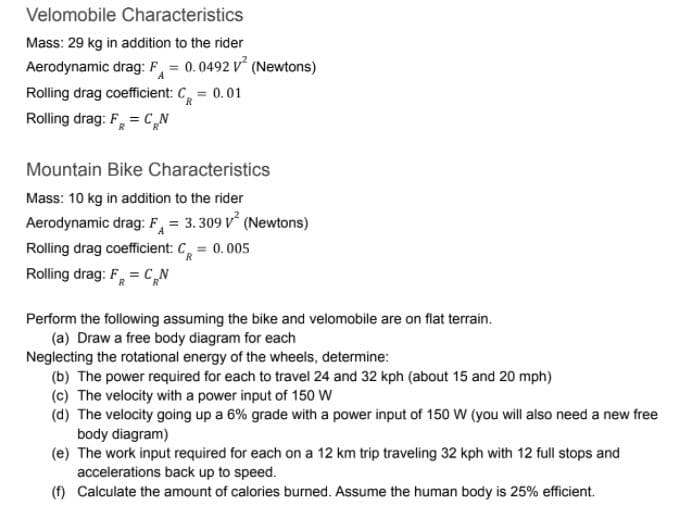Velomobile Characteristics Mass: 29 kg in addition to the rider Aerodynamic drag: F = 0.0492 V (Newtons) Rolling drag coefficient: C, = 0.01 Rolling drag: F, = C,,N Mountain Bike Characteristics Mass: 10 kg in addition to the rider Aerodynamic drag: F, = 3. 309 V° (Newtons) Rolling drag coefficient: C Rolling drag: F, = C,N 0.005 %3D Perform the following assuming the bike and velomobile are on flat terrain. (a) Draw a free body diagram for each Neglecting the rotational energy of the wheels, determine: (b) The power required for each to travel 24 and 32 kph (about 15 and 20 mph) (c) The velocity with a power input of 150 W (d) The velocity going up a 6% grade with a power input of 150 W (you will also need a new free body diagram) (e) The work input required for each on a 12 km trip traveling 32 kph with 12 full stops and accelerations back up to speed. (f) Calculate the amount of calories burned. Assume the human body is 25% efficient.
Velomobile Characteristics Mass: 29 kg in addition to the rider Aerodynamic drag: F = 0.0492 V (Newtons) Rolling drag coefficient: C, = 0.01 Rolling drag: F, = C,,N Mountain Bike Characteristics Mass: 10 kg in addition to the rider Aerodynamic drag: F, = 3. 309 V° (Newtons) Rolling drag coefficient: C Rolling drag: F, = C,N 0.005 %3D Perform the following assuming the bike and velomobile are on flat terrain. (a) Draw a free body diagram for each Neglecting the rotational energy of the wheels, determine: (b) The power required for each to travel 24 and 32 kph (about 15 and 20 mph) (c) The velocity with a power input of 150 W (d) The velocity going up a 6% grade with a power input of 150 W (you will also need a new free body diagram) (e) The work input required for each on a 12 km trip traveling 32 kph with 12 full stops and accelerations back up to speed. (f) Calculate the amount of calories burned. Assume the human body is 25% efficient.
Principles of Heat Transfer (Activate Learning with these NEW titles from Engineering!)
8th Edition
ISBN:9781305387102
Author:Kreith, Frank; Manglik, Raj M.
Publisher:Kreith, Frank; Manglik, Raj M.
Chapter5: Analysis Of Convection Heat Transfer
Section: Chapter Questions
Problem 5.49P
Related questions
Question
A velomobile is a bicycle or tricycle with a full aerodynamic fairing. The aerodynamics of a velomobile are far better than a cyclist on a typical mountain bike. We are going to assume the rider has a mass of 70 kg.

Transcribed Image Text:Velomobile Characteristics
Mass: 29 kg in addition to the rider
Aerodynamic drag: F = 0.0492 V (Newtons)
Rolling drag coefficient: C, = 0.01
Rolling drag: F, = CN
Mountain Bike Characteristics
Mass: 10 kg in addition to the rider
Aerodynamic drag: F, = 3. 309 V° (Newtons)
Rolling drag coefficient: C, = 0.005
Rolling drag: F, = C„N
Perform the following assuming the bike and velomobile are on flat terrain.
(a) Draw a free body diagram for each
Neglecting the rotational energy of the wheels, determine:
(b) The power required for each to travel 24 and 32 kph (about 15 and 20 mph)
(c) The velocity with a power input of 150 W
(d) The velocity going up a 6% grade with a power input of 150 W (you will also need a new free
body diagram)
(e) The work input required for each on a 12 km trip traveling 32 kph with 12 full stops and
accelerations back up to speed.
(f) Calculate the amount of calories burned. Assume the human body is 25% efficient.
Expert Solution
This question has been solved!
Explore an expertly crafted, step-by-step solution for a thorough understanding of key concepts.
This is a popular solution!
Trending now
This is a popular solution!
Step by step
Solved in 5 steps with 1 images

Knowledge Booster
Learn more about
Need a deep-dive on the concept behind this application? Look no further. Learn more about this topic, mechanical-engineering and related others by exploring similar questions and additional content below.Recommended textbooks for you

Principles of Heat Transfer (Activate Learning wi…
Mechanical Engineering
ISBN:
9781305387102
Author:
Kreith, Frank; Manglik, Raj M.
Publisher:
Cengage Learning

Principles of Heat Transfer (Activate Learning wi…
Mechanical Engineering
ISBN:
9781305387102
Author:
Kreith, Frank; Manglik, Raj M.
Publisher:
Cengage Learning